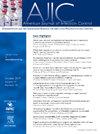针对耐碳青霉烯类鲍曼不动杆菌感染的多层次感染控制干预:间断时间序列。
IF 3.8
3区 医学
Q2 INFECTIOUS DISEASES
引用次数: 0
摘要
背景:耐碳青霉烯类鲍曼不动杆菌(CRAB)会导致危重病人在医院获得性感染,危及生命。由于重症监护病房(ICU)床位有限,这些患者通常在以色列内科病房(IMW)的高依赖性(HD)非重症监护病房接受治疗。我们的目的是评估多层次感染控制干预措施对内科病房(尤其是存在 CRAB 传播的 HD 非重症监护病房)CRAB 感染率的影响:从 2019 年 1 月到 2022 年 6 月,我们开展了一项带有对照结果的前后间断时间序列准实验研究。我们在 3.5 年的时间里进行了多层次干预,包括 4 个阶段:1) 干预前;2) 干预引入:引入强化环境清洁;3) 干预阶段 1:引入主动监测;4) 干预阶段 2:除先前采取的持续措施外,引入 CRAB 阳性患者队列:从 204 名患者中分离出 CRAB,年龄为 69.8 岁/o ± 15.86 岁,59.8% 为男性。其中 34.3% 的患者临床样本呈 CRAB 阳性。平均住院时间为 30.5 天,出院后 30 天的死亡率为 55.9%。CRAB临床病例平均值从干预前的0.89降至第二阶段结束时的0.11,干预后的斜率和水平变化分别为p= 0.02(CI:-0.204-至-0.040)和p=0.004(CI:-0.013-至-0.003):这种多层次的干预措施,包括加强环境清洁、主动监测和患者分组,成功地减少了IMW及其HD非ICU中CRAB的获得。本文章由计算机程序翻译,如有差异,请以英文原文为准。
A multilayered infection control intervention on carbapenem-resistant Acinetobacter baumannii acquisition: An interrupted time series
Background
Carbapenem-resistant Acinetobacter baumannii (CRAB) causes life-threating hospital-acquired. Due to a limited number of Intensive-Care-Unit (ICU) beds, these patients are often treated in high-dependency (HD) non-ICUs within internal-medicine wards (IMW) in Israel. We aimed to assess the effectiveness of a multilayered infection-control intervention on CRAB infection rate in IMWs, especially in its HD non-ICUs with ongoing CRAB transmission.
Methods
A quasi-experimental, before-and-after, interrupted time-series study with control outcomes. We conducted a multilayered intervention over 3.5 years, which included 4 phases: (1) Pre intervention; (2) Intervention introduction: introduced enhanced environment cleaning; (3) Intervention phase 1: introduced active surveillance; (4) Intervention phase 2: introduced CRAB-positive patient cohorting, in addition to previous ongoing measures taken.
Results
CRAB was isolated from 204 patients aged 69.8y/o ± 15.86y, 59.8% male, 34.3% had CRAB-positive clinical samples. Mean hospital length-of-stay was 30.5 days, with a 30-day postdischarge mortality rate of 55.9%. Mean CRAB clinical cases decreased from 0.89 in preintervention to 0.11 at the end of phase 2, with a change in slope and level after the intervention of P = .02 (CI: − 0.204 to − 0.040) and P = .004 (CI: − 0.013 to − 0.003), respectively.
Conclusions
This intervention, including enhanced environment cleaning, active surveillance, and patient cohorting, successfully reduced CRAB acquisition in IMWs and their HD non-ICUs.
求助全文
通过发布文献求助,成功后即可免费获取论文全文。
去求助
来源期刊
CiteScore
7.40
自引率
4.10%
发文量
479
审稿时长
24 days
期刊介绍:
AJIC covers key topics and issues in infection control and epidemiology. Infection control professionals, including physicians, nurses, and epidemiologists, rely on AJIC for peer-reviewed articles covering clinical topics as well as original research. As the official publication of the Association for Professionals in Infection Control and Epidemiology (APIC)

 求助内容:
求助内容: 应助结果提醒方式:
应助结果提醒方式:


